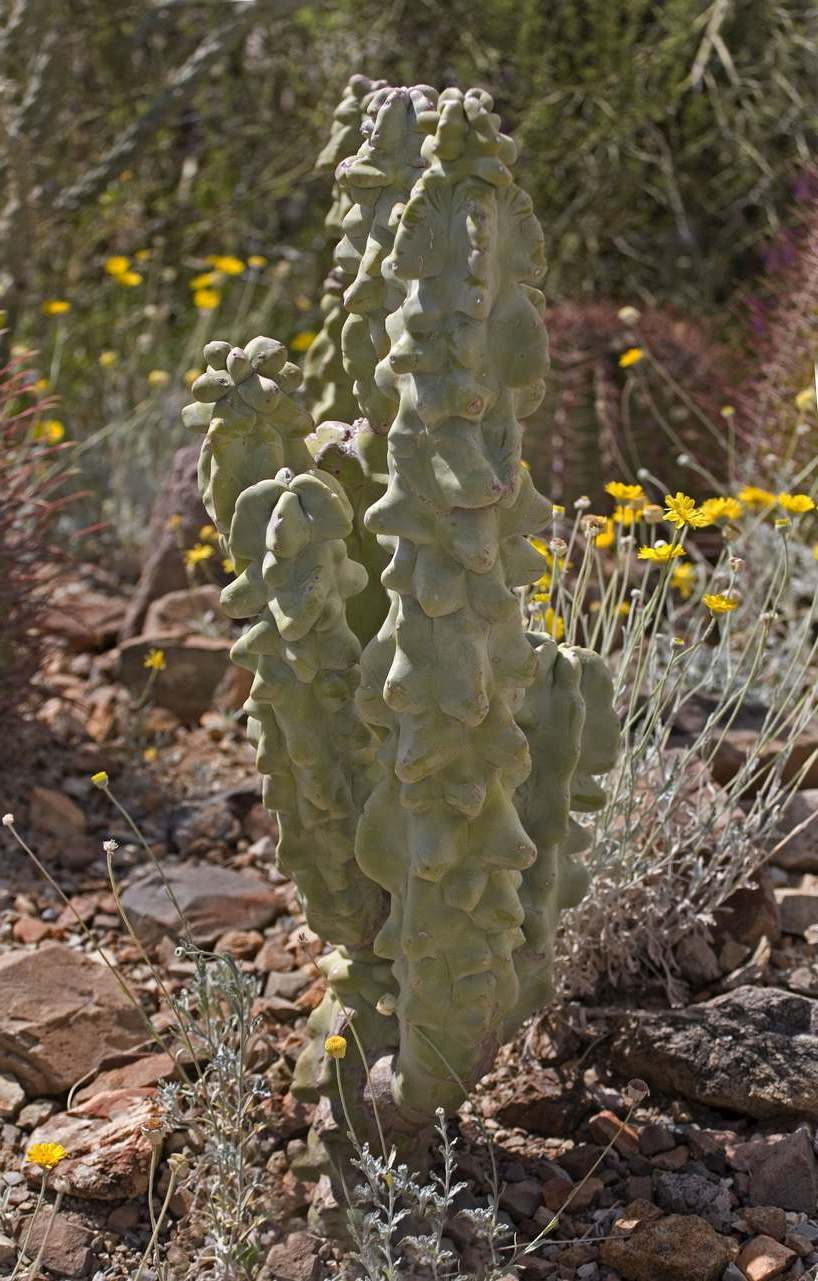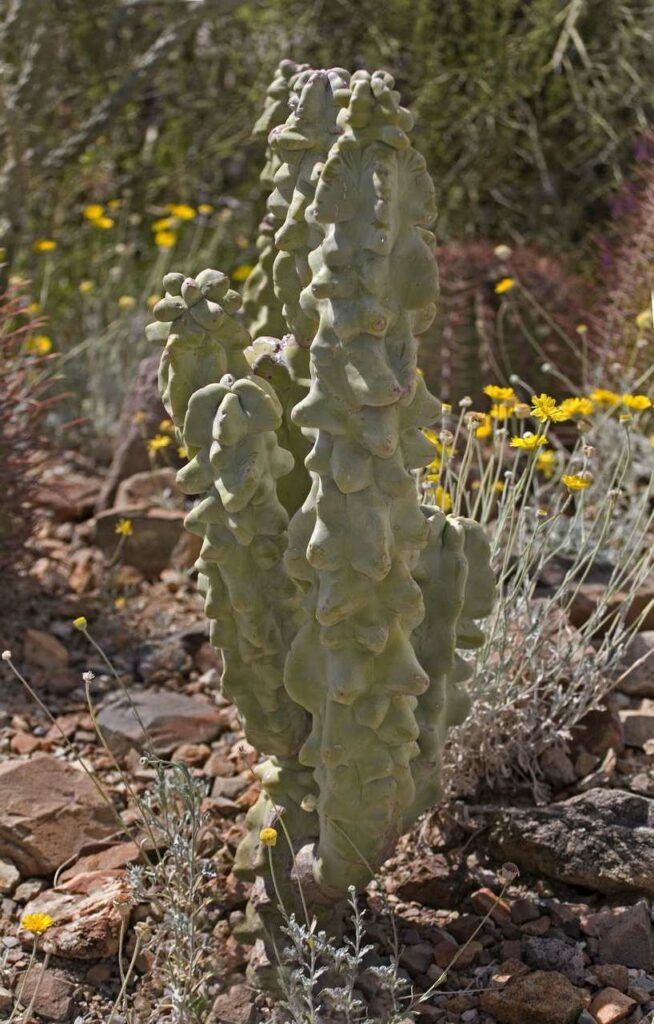Totem Pole Cactus – How To Grow And Care For Totem Pole Cacti
The totem pole cactus stands tall as a testament to the ingenuity and creativity of Mother Nature. Few succulents can match this slender and elegant cactus in terms of beauty, hardiness, or low-maintenance and care. The full-grown plant looks like a fine piece of sculpture that brings a touch of classy sensuality and style to every home and garden.
You can grow it as a houseplant or right there in your garden where its unfading beauty shines on regardless of the season or weather conditions. Only a few succulents, let alone plants display such effusive charm and originality as the totem pole cactus. So if all of this praise and build up got you intrigued and you’re eager to add this unique succulent to your cactus collection, this post will be your guide. From planting to growing and caring for this illustrious and artistic cacti, we got you covered.
All About the Totem Pole Cactus
Originally growing in the deserts of Mexico, Arizona, and Southern California, the totem pole cactus (Lophocereus schottii f. monstrosus) had a special significance for the Native Americans. The scientific name implies that the plant is huge which explains the other names this cactus goes by. They include Monstrous Whisker cactus and Totem cactus. It has USDA hardiness zones between 9 and 10.
But this is not a normal cactus species we’re talking about. The totem cactus is a mutation that takes its time to reach its full height. But it won’t stop growing before hitting anything between 7 to 10 feet. Some varieties can easily reach 20 feet in the right conditions. As for girth, this cactus averages between 4 to 7 inches in diameter.
The cactus resembles a totem in so many ways, it’s often maintained that the first totems were inspired by this hardy and proud succulent standing alone in the harsh desert. Most of the plant’s mass is actually water. So in a way, the body of the cactus is veritable water storage.
It has smooth skin littered with knobby swellings. It is rare for the surface to be covered with spikes or thorns, unlike other cacti species.
In the late spring, the mature cactus will bloom pale pink flowers. However, since the flowers bloom at night, it takes a dedicated cactus lover to observe them. The flowers are merely for ornamental purposes since the totem pole cactus is a seedless plant.
Totem Pole Cactus Varieties
Unlike many other more popular succulents, the totem pole cactus doesn’t have any cultivars. All the different varieties that you can grow in your garden are natural species. They vary in shape, size, and growing condition so much that you’ll need to pick the right variety for your own climate and landscaping needs. Out of about 12 species in the Pachycereus family, we selected those popular varieties for your consideration.
- Pachycereus Marginatus: A spindly columnal cactus variety that grows to 20 feet tall with ease. It needs a lot of space to grow although the thorny stems hardly grow beyond 5 inches in diameter. A mature cactus has one central stem with about 5 other stems growing out of it at the base.
- Pachycereus Pecten-Aboriginum: A giant of a cactus that reaches 50 feet in the wild. The base of this succulent grows to 10 inches in diameter. Each stem has about 12 ribs covered with sharp thorns. It blooms white flowers in the early evening that stay in bloom until the morning of the next day. After the flowers pollinate, they fade and juicy fruits develop in their place. The fruits become ripe by the end of June and are sweet and packed with flavors.
- Pachycereus Pringlei: Known as the elephant cactus it grows to 60 feet tall and 3.3 feet wide. The main stem branches out near the base and can grow even in bare rock. Bacteria provide the cactus with the nutrients it needs as it breaks the rock. It doesn’t produce fruits or flowers and needs plenty of space to grow.
- Pachycereus Schottii: A convenient variety both indoors and outdoors since it averages between 7 to 10 feet high at maturity. Its flowers are also nocturnal and the only night pollinator that can accommodate it is the senita moth which lives in the Sonoran Desert. This explains why the flowers will stay unpollinated when you grow this variety in your garden.
How to Grow Totem Pole Cactus
Unpollinated flowers can only mean one thing, that the totem pole cactus cannot produce seeds. So if you want to plant this succulent in your garden or home, you’ll need to have a cutting from a grown plant. It’s either that, or you could buy a small plant at the local nursery. Here’s how to grow it from a cutting in easy steps.
- The best time to grow totem pole cactus is in the late spring or early summer.
- Select a healthy growing cactus and cut a 12-inch piece from the top stem. Use a sterilized knife and cut the stem at an angle to prevent water pooling on the cut stump.
- Disinfect the cut both on the stem and the stump with bleach to prevent infections and keep the mother plant from losing water.
- Keep the cutting in a warm and dry place away from the sunlight. Between a week or two after that, a dry crust grows on the cut end to indicate that the cutting is healed.
- Choose a small pot and fill it with a special rooting medium. You can make your own by mixing half portion perlite and half peat moss. Fill half the pot with the rooting medium and add a thick layer of chicken grit.
- Place the cactus cutting in the grit and fill the rest of the pot with the coarse grit. The grit will prevent water from pooling around the cut end of the cutting.
- Water the pot enough to get the rooting medium moist but not wet.
- Set the pot aside in a warm and shaded place.
- Water the plant once a week but don’t overwater it.
- After about 3 to 6 weeks, the cutting will develop roots. Now you can water it regularly but allow the top layer of the mix to dry out between irrigations.
Totem Pole Cactus Care
If a succulent can handle itself in the merciless Sonora Desert the way the totem pole cactus does, that means it is easy to care for and maintain. As the cactus slowly grows, you’ll need to repot it regularly to accommodate the robust stems and roots.
Soil
As is often the case with exotic plants that grow in different conditions than the one you have in your garden, you need to adjust your soil to accommodate this totem pole cactus. In this case, you need to make sure the soil is sandy and well-drained. If you grow the cactus in your garden, you will need to break the top 10 inches of soil and mix in a generous portion of perlite and coarse sand. Every couple of years, repeat this process to refresh the soil and replenish the nutrients. If you’re growing it in a container, then add the same ingredients to a cactus potting mix in equal measures.
Light
The light requirements of the totem pole cactus vary depending on whether you grow it as a houseplant or out in the garden. Outdoors, this cactus will thrive in very hot conditions that other succulents cannot tolerate. The more sunlight and reflected heat it gets, the bigger and it grows.
When you grow it indoors, you need to place the pot in a window that gets the full sun all day long. If the plant gets less than 8 hours of sun a day it will look sickly and distressed. The erect stems turn yellow and become soft as a result of sun deprivation. You can use sun lamps and increase the temperature in the room to compensate for the lack of natural sunlight.
Watering
Even though the totem pole cactus stores water in its massive stems, that doesn’t mean it likes too much watering. The exact opposite is true. This is why your need to adjust the soil and make it drain fast. In the desert, water is scarce, and that’s exactly how this hardy cactus prefers it. In the early stages of the plant’s life, you will need to water it regularly about once a week. You should wait for the top two inches of soil to dry out before you irrigate it. But once the plant establishes, its water needs will become less frequent. So cut your irrigation down to about once every 3 weeks. Aim the water at the base of the stem and soak the soil thoroughly every time.
Temperature and Frost
The desert is known for its harsh weather conditions and the totem pole cactus can tolerate very high and moderately low temperatures. But one thing it cannot tolerate is frost. If you happen to get frost in the winter, then you should consider keeping your cactus in a container and bringing it indoors before the first frost. The same applies to frigid conditions at night. If the temperature drops below 24 degrees, then your cactus should spend the winter inside your house. Once the weather improves in the spring, you can bring the plant out again after the last frost.
Pests and Diseases
There are no known pests or bugs that feed on the totem pole cactus or cause it harm. The thick skin on those stems makes it hard for bugs to breach that robust layer of protection to get to the juicy pulp inside. As for diseases, you only have to watch out for root rot. It’s common for all succulents that grow in less than optimal soil to suffer from root rot. So ensure you only water the plant when the soil is dry and that the soil is sandy and well-drained.

